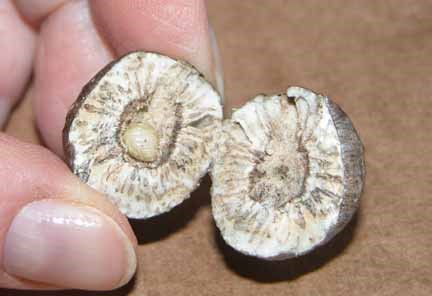The goldenrod gall fly, Eurosta solidaginis (Fitch) (Diptera, Tephritidae), is widely distributed across North America. The life cycle of this insect is centred on the goldenrod plant (Solidago sp.). Females lay eggs in the growing tips of goldenrod plants in the spring and when they hatch the larvae bore into the center of the stem and start to eat. Secretions of the larvae mimic plant hormones and cause the plant to form a ball gall around them and to stock the inside of the gall with cells that are high in nutrients which the larvae eat. By early autumn the third (final) instar larvae have reached their maximum size. As a final task (about mid-October in the Ottawa area), they eat a tunnel out to near the surface of the gall (leaving just the epithelium intact) and then settle back into the center of the gall to spend the winter. The larvae respond to autumn cues (shorter days, cooler temperatures, senescence of the plant) by preparing for winter by both entering diapause (a state of arrested development and hypometabolism) and implementing cryoprotection. Eurosta larvae are freeze tolerant.
They survive temperatures as low as ‑35°C in southern Canada and the conversion of ~65 % of their total body water into extracellular ice. To aid survival, they synthesize two cryoprotectants, glycerol and sorbitol, from glycogen reserves that they built up over the summer. High levels of the cryoprotectants protect the intracellular environment while ice accumulates outside the cells. The larvae also employ ice nucleators to make sure that they start to freeze at relatively high subzero temperatures of about -8 to -10°C. By doing so, they can more carefully regulate the freezing process. Locked within the galls that often protrude above the snowpack, the larvae may freeze and thaw many times over the winter, sometimes on a daily basis. Diapause ends after 3-4 months and although it is still winter, the larvae begin to slowly modify their metabolism so that when they detect consistent warming in April, they begin to break down their cryoprotectants and use these as nutrients to prepare for pupation in late April or early May. After 2-4 weeks, the adults hatch, walk up the tunnel, push their way through the surface skin, and then set off to start the cycle again.


Life inside a tough gall may seem secure (and boring) but it is not risk free – various predators have learned to exploit the larvae. Eurosta are attacked in the summer by parasites and predators. The main parasites are the wasps Eurytoma obtusiventris and Eurytoma gigantea that use long ovipositors to penetrate the galls and deposit eggs into the larvae which then become a captive food supply for the wasp youngsters. Larva of the beetle Mordellestina unicolor can also bore into a gall and eat its contents. In the autumn, Downy woodpeckers and chickadees eagerly await the construction of the exit tunnel, then tap on galls to find the tunnel and bore in to get the juicy larva which is a high fat, high sugar winter treat for them.